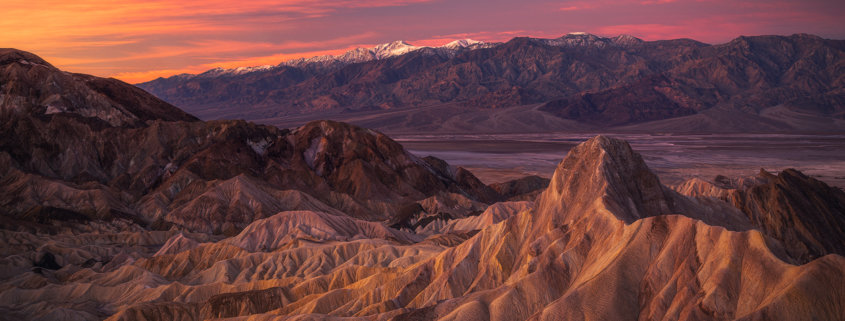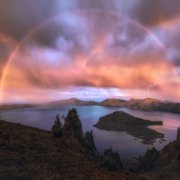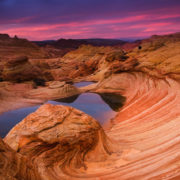Different Types of Light in Landscape Photography
Landscape photography is all about capturing light, quite literally. Without light, there wouldn’t be much to photograph (let alone see). In this article, I discuss different types of light and how landscape photographer can use that light to come away with breath taking photos.
Golden Hours
Let’s start with the obvious, light at golden hours. This is the time when most photographers seem to be active and creating their images. Seeing a blazing sunrise or sunset always feels like a gift, but photographing them can get tricky in intense light. To get the best light out of a sunrise or sunset, look for clouds that may light up and a gap on the horizon for the sun to poke through. Landscape photography before or after a storm often provides the most dramatic golden hour photos. Check the weather beforehand and see if there is any cloud cover in the early morning or evening you wish to photograph.
Often times, a wide angle lens is used to capture these stunning and colorful displays. This is one of the few times where I find myself using an ultra wide angle lens to really fit as much sky into the scene as I can. Try using zoom lenses and telephoto lenses if the light is further off in the distance to isolate the best light. From my experience, the best color in the sky happens just after official sunset and just before official sunrise. This also allows you to not have to worry about your shadow being in your foreground.
Really intense light can create a warm color cast over the entire scene. In post, I like to create a duplicate layer and create a layer mask for adjustments. Usually, these are color adjustments like color balance or white balance in camera RAW. This way, you can still retain the colors in the sky while giving the scene some color contrast. The most problematic areas are the shadows, which should have a cooler feel, opposed to the highlights of the scene. For very intense light, I also recommend bracketing and making multiple exposures for the sky and landscape to later blend in post for dynamic range. Sometimes even the best sensors can’t handle the dynamic range of these scenes.

Landscape photography during Golden Hours – Panamint mountains and Zabriskie Point, Death Valley National Park, California
The landscape photo above showcases golden hours at the Panamint mountains and Zabriskie Point in Death Valley National Park. The intense colors of the sunrise gave the badlands a warmer color palette which was reduced by shifting the white balance in a duplicate RAW file to a cooler tone.
Reflected Light
Many photographers tend to call it a day once the light becomes too harsh. However, some of the most interesting light can occur throughout the midday hours. Reflected light in landscape photography is a common form of light that usually occurs during mid-morning and afternoon. This type of light can occur in places like slot canyons. Certain angles of the sun may illuminate one side of a canyon wall, which reflects onto an opposing wall or feature with rich glowing light.
This type of light can also occur during golden hours with colorful clouds reflecting the warmth onto the landscape. However, in this instance we refer to the later-in-the-day type. Much like sunrise and sunset, the warm colors of a reflected canyon wall may create an unflattering color cast in the shadows. Once again, it’s time to do some color adjustments to create contrast. As I mentioned before, I prefer using a duplicate layer for these adjustments. This allows you to click back and forth to see what your adjustment is doing, and if you need to further your adjustments.
In the landscape photo above dried mud curls catch the reflected light from the sandstone wall above. This wall had this nice glow from an opposing canyon wall fully illuminated to provide the glow here. Notice how the shadows still retain the cool tones here and the highlights in the mud show the warmer light.
Dappled Light
Another form of light that can occur during daylight hours is dappled light. This type of light happens when there are patchy clouds in the sky and the sun breaks through creating speckled patterns of light and shadow over the landscape. This can happen over any type of landscape, but it is most photogenic when you have layers in the landscape. Mountains, valleys, and canyons work well for this type of light due to the uneven terrain. I find vantages high up offer great perspectives to take advantage of this light.
Dappled light can even be just as dramatic as sunrise and sunset light. Depending on how much light and shadow you have, your scene can look like something out of Mordor. This type of light works great with high contrast processing to really separate the highlights and shadows. Just like the other light mentioned in this article, it is still possible to get color casts. It is best practice to ensure that your shadows remain a cooler tone than your highlights.
This image showcases afternoon dappled light over Death Valley National Park. The darker areas over the landscape are shadows from the clouds, while the highlights pop in random sections. The speckling of light is most notable in the upper half of the image.
Twilight
After the sun sets, then photography is surely over as there is no more light to work with, right? Wrong! Twilight offers one of the more unique displays of light for landscape photography. This type of light typically occurs about 30 minutes before sunrise and 30 minutes after sunset. Because the sun is below the horizon, we don’t have to deal with a lot of warm tones. Twilight colors are more about the pastel blues and pinks that occur in nature. This should make it a lot easier to avoid a color cast, right? Wrong again! While all of the other light displays we’ve discussed can create a warm color cast, twilight can create very blue or magenta color casts.
There are specific colors to look for and adjust to avoid any color casts: blues, cyans, purples, and magentas. Snowy scenes under twilight light may appear to have more cyans and blues while other scenes may show too much purple and magenta. Using the color balance tool on a duplicate layer via a layer mask can help balance your scene. Here you can adjust your cyans, blues, and purples without adjusting the entire scene.
Be sure to click on and off on the layer as you mask out areas to make sure the color cast is diminishing. You can get creative with your colors though, and maybe you want the scene to appear more blue or purple. Just make sure that the entire scene isn’t one uniform color.
This landscape photo was taken during twilight over Toroweap Point in Grand Canyon National Park. Note the much cooler tones in the landscape. It is common to have faint sunset or sunrise light linger in the sky with intense displays of light.
Hopefully this article helps you discover other types of light in nature to photograph, especially if you tend to shoot only during golden hours. Great light happens all day long if you know how to spot it. Now you can shoot all day long if the conditions are right.









 Grant Collier
Grant Collier


